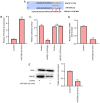MicroRNA‑200c‑3p suppresses intervertebral disc degeneration by targeting RAP2C/ERK signaling
- PMID: 34676879
- PMCID: PMC8554383
- DOI: 10.3892/mmr.2021.12505
MicroRNA‑200c‑3p suppresses intervertebral disc degeneration by targeting RAP2C/ERK signaling
Abstract
Intervertebral disc degeneration (IDD) is a major cause of lower back pain. The high morbidity associated with this disease diminishes the quality of life of those who are affected. MicroRNAs (miRs) play crucial roles in various diseases, including IDD. However, the mechanism via which miR‑200c‑3p plays a role in the development of IDD remains unknown. The present study aimed to investigate the effect of miR‑200c‑3p on the progression of IDD and the underlying mechanism. The expression level of miR‑200c‑3p was evaluated in intervertebral disc tissues from patients with IDD. To construct the IDD cell model, the nucleus pulposus (NP) cells were treated with lipopolysaccharide (LPS) 24 h following transfection with miR‑200c‑3p mimic or inhibitor. A luciferase activity assay was performed, while reverse transcription‑quantitative PCR and western blotting were conducted to determine the RNA and protein expression levels, respectively. The expression level of miR‑200c‑3p in the intervertebral disc tissues of patients with IDD was lower than that of normal subjects. LPS treatment reduced the expression level of miR‑200c‑3p in NP cells. Moreover, miR‑200c‑3p mimic inhibited LPS‑induced NP cell apoptosis. It was found that miR‑200c‑3p attenuated inflammatory cytokine levels and extracellular matrix (ECM) degradation in NP cells. Furthermore, miR‑200c‑3p targeted Ras‑related protein 2C (RAP2C) in NP cells. RAP2C promoted apoptosis, inflammatory cytokine levels and ECM degradation by activating ERK signaling. Knockdown of RAP2C and inhibition of ERK signaling by SCH772984 partially reversed the proinflammatory effect of the miR‑200c‑3p inhibitor on LPS‑treated NP cells. Thus, miR‑200c‑3p inhibits NP cell apoptosis, inflammatory cytokine levels and ECM degradation in IDD by targeting RAP2C/ERK signaling.
Keywords: ERK signaling; IDD; NP cells; RAP2C; miR‑200c‑3p.
Conflict of interest statement
The authors declare that they have competing interests.
Figures






Similar articles
-
miR‑654‑5p inhibits autophagy by targeting ATG7 via mTOR signaling in intervertebral disc degeneration.Mol Med Rep. 2021 Jun;23(6):444. doi: 10.3892/mmr.2021.12083. Epub 2021 Apr 13. Mol Med Rep. 2021. PMID: 33846806 Free PMC article.
-
Long non-coding RNA PART1 promotes intervertebral disc degeneration through regulating the miR‑93/MMP2 pathway in nucleus pulposus cells.Int J Mol Med. 2020 Jul;46(1):289-299. doi: 10.3892/ijmm.2020.4580. Epub 2020 Apr 16. Int J Mol Med. 2020. PMID: 32319551 Free PMC article.
-
CircRNA-CIDN mitigated compression loading-induced damage in human nucleus pulposus cells via miR-34a-5p/SIRT1 axis.EBioMedicine. 2020 Mar;53:102679. doi: 10.1016/j.ebiom.2020.102679. Epub 2020 Feb 26. EBioMedicine. 2020. PMID: 32114390 Free PMC article.
-
Mechanisms and functions of long noncoding RNAs in intervertebral disc degeneration.Pathol Res Pract. 2022 Jul;235:153959. doi: 10.1016/j.prp.2022.153959. Epub 2022 May 28. Pathol Res Pract. 2022. PMID: 35653923 Review.
-
Regulatory Effect of Inflammatory Mediators in Intervertebral Disc Degeneration.Mediators Inflamm. 2023 Apr 17;2023:6210885. doi: 10.1155/2023/6210885. eCollection 2023. Mediators Inflamm. 2023. PMID: 37101594 Free PMC article. Review.
Cited by
-
The new ceRNA crosstalk between mRNAs and miRNAs in intervertebral disc degeneration.Front Cell Dev Biol. 2022 Dec 2;10:1083983. doi: 10.3389/fcell.2022.1083983. eCollection 2022. Front Cell Dev Biol. 2022. PMID: 36531954 Free PMC article.
-
Circ_0005918 Sponges miR-622 to Aggravate Intervertebral Disc Degeneration.Front Cell Dev Biol. 2022 Jul 8;10:905213. doi: 10.3389/fcell.2022.905213. eCollection 2022. Front Cell Dev Biol. 2022. PMID: 35874804 Free PMC article.
-
Pyroptosis and Intervertebral Disc Degeneration: Mechanistic Insights and Therapeutic Implications.J Inflamm Res. 2022 Oct 17;15:5857-5871. doi: 10.2147/JIR.S382069. eCollection 2022. J Inflamm Res. 2022. PMID: 36263145 Free PMC article. Review.
References
-
- Zhang Q, Weng Y, Jiang Y, Zhao S, Zhou D, Xu N. Overexpression of miR-140-5p inhibits lipopolysaccharide-induced human intervertebral disc inflammation and degeneration by downregulating toll-like receptor 4. Oncol Rep. 2018;40:793–802. - PubMed
MeSH terms
Substances
LinkOut - more resources
Full Text Sources
Molecular Biology Databases
Miscellaneous

